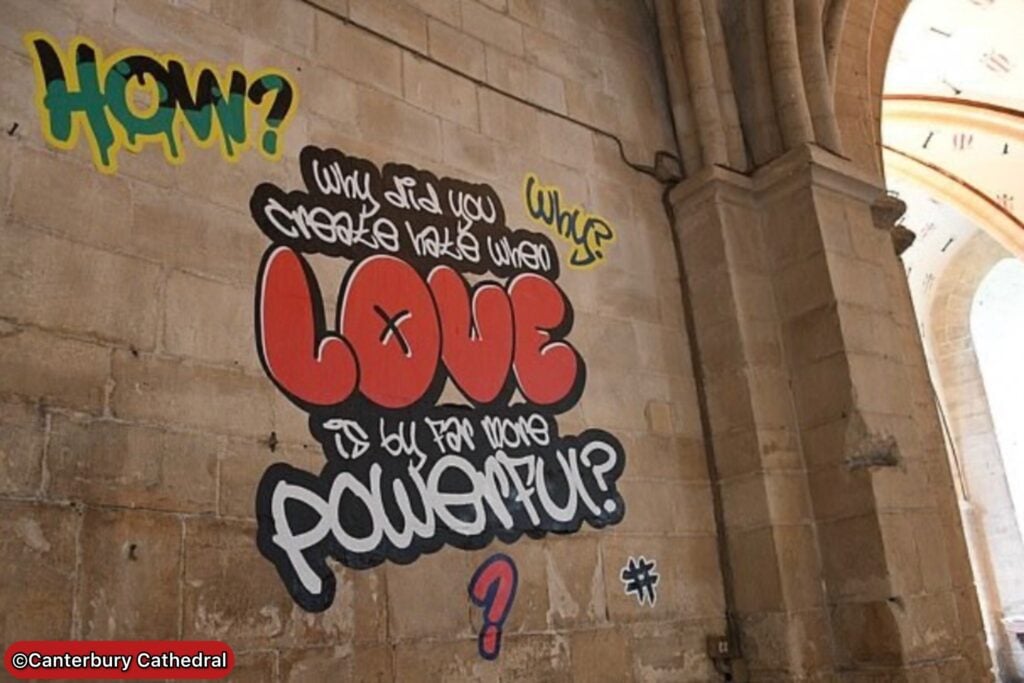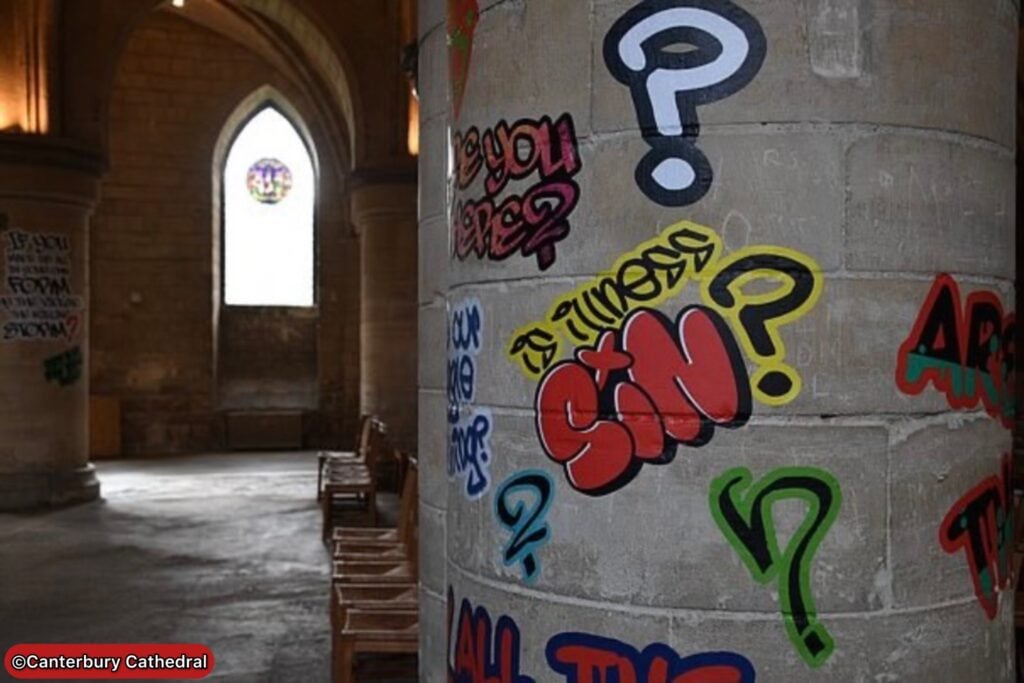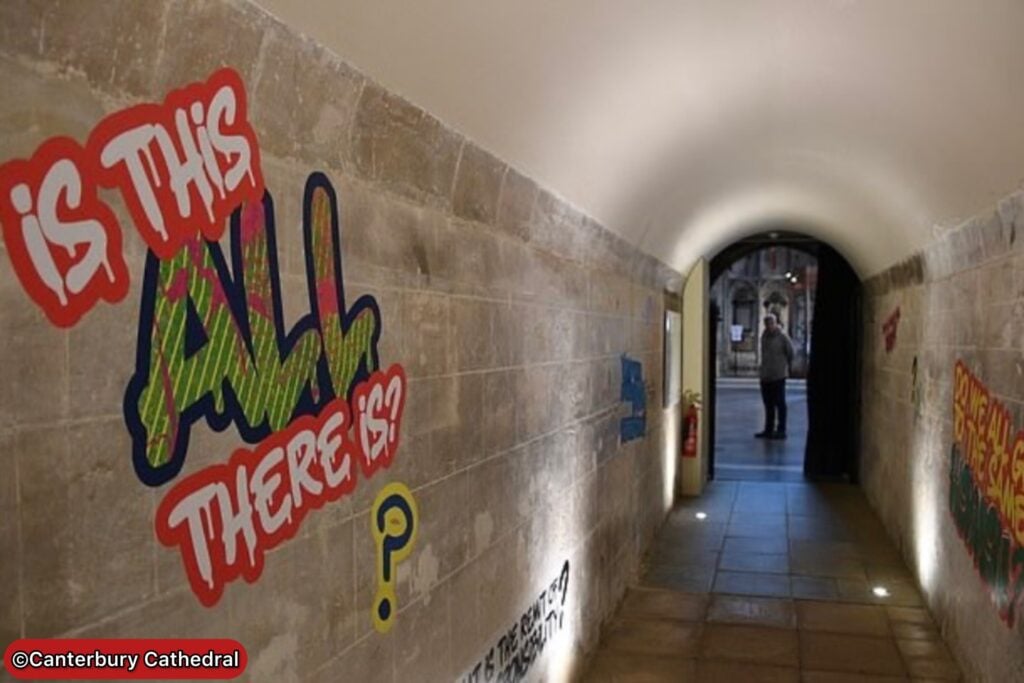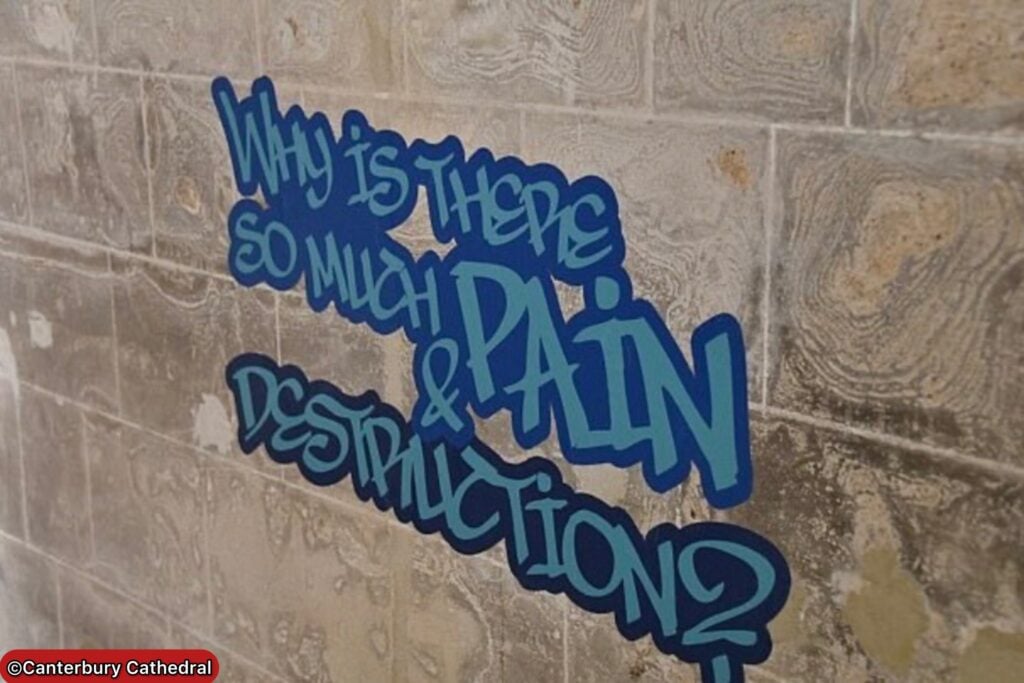US Vice President JD Vance weighs in on controversial ‘Hear Us’ installation featuring questions to God plastered across ancient pillars and walls
A graffiti-style art exhibition at Canterbury Cathedral has sparked fury amongst worshippers, with critics branding the installation “sacrilegious” and claiming it makes the 1,400-year-old building resemble “an underground car park in Peckham”.
The controversial artwork, titled “Hear Us”, features brightly coloured questions to God plastered across the cathedral’s historic stone pillars, walls and floors, prompting visceral reactions from visitors ahead of its official launch on Friday.
The installation has divided opinion so sharply that US Vice President JD Vance entered the fray, writing on X: “It is weird to me that these people don’t see the irony of honouring ‘marginalised communities’ by making a beautiful historical building really ugly.

“Who Will Rid Me of These Troublesome Graphics?”
Social media erupted with criticism of the temporary exhibition, which runs until 18 January 2026. One observer asked: “Who will rid me of these troublesome graphics?” whilst another questioned: “How do people not tire of the cringe?”
“This is awful. Canterbury Cathedral, what are you doing?” demanded one critic, whilst another stated: “Not the kind of ‘art’ I’d expect in an ancient Gothic cathedral.”
Several commentators questioned why the artwork couldn’t be presented on canvas instead. “Whoever approved this genuinely can’t have thought people wouldn’t be annoyed and disgusted by its presentation, surely?” one person wrote.
The graffiti-style lettering has been affixed alongside the cathedral’s genuine historical graffiti, including ancient masons’ marks, crosses and Christograms dating back centuries, some as far as 1667.

Questions Range from Existential to Provocative
The installation features responses to the question “What would you ask God?” in bold, street art-style lettering. Queries include “Are you there?”, “Why did you create hate when love is by far more powerful?”, “Does everything have a soul?” and “Do you regret your creation?”
The questions emerged from community workshops conducted earlier this year by poet Alex Vellis and curator Jacquiline Creswell, who collaborated with what they described as “marginalised communities” including Punjabi, Black and brown diaspora, neurodivergent individuals and LGBTQIA+ groups.

Dean Defends “Disruptive” Installation
David Monteith, Dean of Canterbury, acknowledged the exhibition’s potential to polarise opinion but defended the provocative approach.
“There is a rawness which is magnified by the graffiti style which is disruptive,” he said. “There is also an authenticity in what is said because it is unfiltered and not tidied up or sanitised.”
“Above all, this graffiti makes me wonder why I am not always able to be as candid, not least in my prayers. This exhibition intentionally builds bridges between cultures, styles and genres and in particular allows us to receive the gifts of younger people who have much to say and from whom we need to hear much.”
“Language of the Unheard”
Poet Alex Vellis described graffiti as “the language of the unheard”, adding: “By temporarily graffitiing the inside of Canterbury Cathedral, we join a chorus of the forgotten, the lost, and the wondrous.”
“People who wanted to make their mark, to say ‘I was here’, and to have their etchings carry their voice through the centuries. This project, at its core, is about community, using your voice, and change.”
Curator Jacquiline Creswell, who previously oversaw art installations at Salisbury Cathedral, said: “Surely we have all wondered about the mysteries of the universe, the meaning of life, or in times of uncertainty, sought advice?”
“Within a theological context, posing a question to God is viewed as a form of prayer, meditation, or contemplation, in return receiving guidance and solace from a source believed to be all-knowing and compassionate.”

Cathedral Acknowledges Divided Response
In a press release, cathedral officials acknowledged the artwork had “split public opinion ahead of its official launch, with visitors reporting visceral reactions to the bold graffiti-style graphics and thought-provoking questions displayed on the ancient walls”.
“While many have reported their delight and intrigue, others have been discomforted by encountering the artworks,” the statement continued.
The cathedral defended the installation by noting its long tradition of graffiti, stating there is “a great variety of historical graffiti within the cathedral, including masons’ marks, religious graffiti in the form of crosses and Christograms, and marks made through the centuries by pilgrims and other visitors”.
Timing Adds to Controversy
The exhibition’s unveiling comes just days after the Right Reverend Sarah Mullally was announced as the first female Archbishop of Canterbury in the cathedral’s 1,400-year history. The artwork will be removed before her enthronement ceremony as the 106th Archbishop of Canterbury.
Founded in 597 AD and rebuilt after the Norman Conquest, Canterbury Cathedral has served as the seat of the Church of England’s spiritual authority for centuries. It was the site of Archbishop Thomas Becket’s martyrdom in 1170 and has been a major pilgrimage destination since the Middle Ages.
The controversy arrives as the Church of England continues to face declining attendance and deep divisions over issues including same-sex blessings and gender identity.
“Hear Us” officially opens on Friday, 17 October and runs until 18 January 2026. The exhibition is free to view with valid cathedral admission.
Follow for more updates on Britannia Daily



